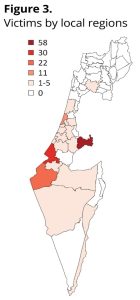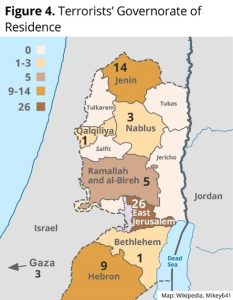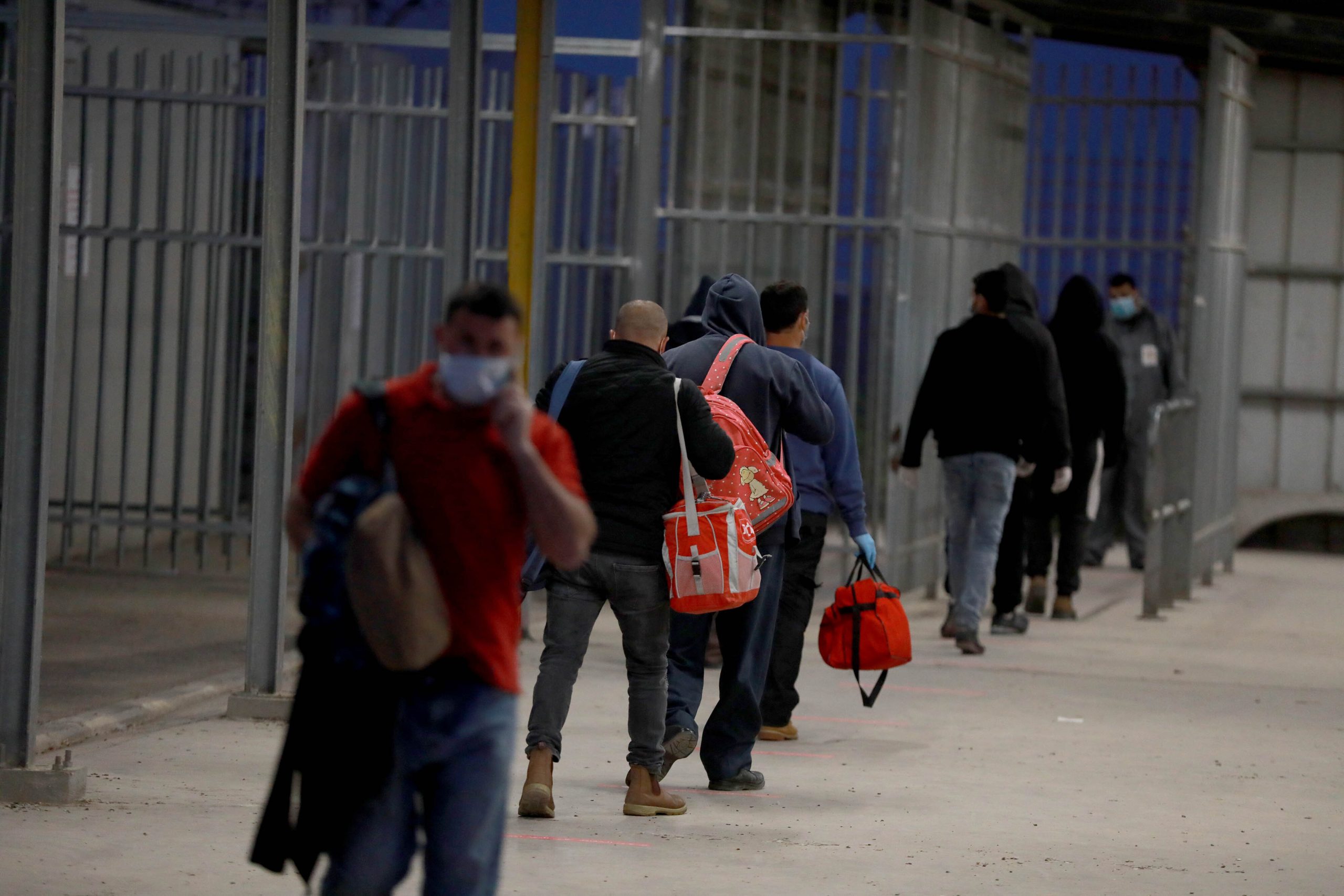Publications
INSS Insight No. 1866, June 17, 2024
This article examines the validity of the claim that granting work permits to Palestinian workers from the West Bank creates a security risk for the citizens of Israel. The analysis is based on an original and new database regarding the 153 Israelis who were murdered within the Green Line (the demarcation line from 1949), including East Jerusalem, from January 1, 2007, to October 6, 2023. The data show that in these 17 years, three attacks were conducted by terrorists with work permits, resulting in the deaths of four people. Approximately 44% of all murdered Israelis were killed by rocket or sniper fire from the Gaza Strip, and another 33% were murdered by terrorists with Israeli citizenship or residency status in East Jerusalem. The conclusion is that attacks carried out by Palestinian workers are rare, and that 77% of the victims during the studied period (118 people) were murdered in attacks that could not have been prevented by prohibiting the entry of Palestinian workers from the West Bank into localities inside the Green Line.
On the eve of the war that began on October 7, around 175,000 Palestinians worked (with and without permits) in Israel and in Israeli settlements in the West Bank, of which 150,000 worked within the Green Line. Since the outbreak of the war, the Israeli government has prohibited the entry of Palestinian workers into localities within the Green Line, except for special permits granted to approximately 8,000 Palestinian workers for exceptional essential needs.
There is a lively debate within the government regarding this policy. The security establishment (excluding the police) supports the entry of Palestinian workers into localities within the Green Line, subject to individual approval of each worker and under certain restrictions. Proponents of renewing the entry permits for Palestinian workers highlight the significant damage to the Israeli economy resulting from the ban on their entry, especially in the construction and agriculture sectors. They also express concern that the economic hardship of the workers’ families might lead some to join terrorist organizations, thus further destabilizing the relative security in the West Bank. However, most of the government ministers oppose the entry of Palestinian workers into Israel. Their main argument is that the entry of these workers poses an unnecessary security risk, especially since several attacks were conducted by terrorists with work permits in Israel.
This study offers a quantitative analysis of the main characteristics of all attacks carried out by Palestinian terrorists within the Green Line over the past 17 years. The research is based on a database of new and original data about all Israelis who were murdered within the Green Line (including East Jerusalem) from January 1, 2007, to October 6, 2023. The database was constructed from open sources and includes detailed information about all the victims, the terrorists, and the key characteristics of each attack, including the date, location, and the weapon used by the terrorists in their killing spree. By using this database, the study examines the claim that the government and the public have made, that Palestinian workers entering Israel with work permits pose a security threat to the citizens of Israel.
Victims of Attacks Within the Green Line
During the period analyzed, 153 Israelis were murdered in 87 attacks. The deadliest attack occurred at the Merkaz Harav Yeshiva in Jerusalem on March 6, 2008, when a terrorist from East Jerusalem shot and killed eight yeshiva students. The second most severe attack also took place in Jerusalem, on January 23, 2023, where a terrorist from East Jerusalem shot and killed seven people, six of whom were Israeli citizens and one a foreign worker.
The number of Israeli victims has fluctuated significantly over time. Figure 1 shows the number of victims since 2007 and the number of Palestinian workers employed in localities within the Green Line (with and without permits) between 2012 and 2023. The data indicates that the years 2008 and 2014 were particularly violent. In contrast, the average number of victims in other years is six per year. Unlike the fluctuation in the number of victims, the number of Palestinian workers from the West Bank employed within the Green Line steadily increased over the years. This trend started immediately after the end of the Second Intifada (the data only begins in 2012). While in the second quarter of 2012, 65,000 workers from the West Bank were employed in localities within the Green Line, this number gradually rose to over 147,000 workers in the third quarter of 2023. The differing trends in the two series lead to an initial conclusion that there is no clear connection between the two variables, with a correlation between them of less than 0.01.

Additional support for this conclusion stems from the fact that most of the victims of attacks within the Green Line were killed by terrorists who were in the Gaza Strip at the time of the attack. Figure 2 tabulates the victims according to the type of weapon used by the terrorist to carry out the attack: explosive devices, live ammunition, rockets (including mortars and anti-tank missiles), cold weapons (knives, stone-throwing, and strangulation), sniper fire from the Gaza Strip, and vehicular attacks. The chart shows that about 44% of all victims (67 in number) met their deaths in attacks launched and fired from the Gaza Strip. This fact also explains the increase in the number of victims in 2008 and 2014, when Israel conducted military operations in the Gaza Strip and massive rocket fire was launched from Gaza into the Israeli communities along the Gaza border and the IDF assembly areas. In these two years, 13 and 27 Israelis, respectively, were killed within the Green Line from fire originating from the Gaza Strip.

 Figure 3 classifies the victims by the location of the attack. It clearly shows that terrorist attacks mostly occurred in three areas: 58 Israelis were murdered in Jerusalem, 52 in the Gaza border communities (Ashkelon and the Besor region), and 11 in Tel Aviv. In each of the other areas, fewer than five Israelis were murdered during the period in question, and in most areas, there were no victims at all.
Figure 3 classifies the victims by the location of the attack. It clearly shows that terrorist attacks mostly occurred in three areas: 58 Israelis were murdered in Jerusalem, 52 in the Gaza border communities (Ashkelon and the Besor region), and 11 in Tel Aviv. In each of the other areas, fewer than five Israelis were murdered during the period in question, and in most areas, there were no victims at all.
Of all the victims in Jerusalem, 51 were murdered by terrorists living in East Jerusalem, who were either Israeli citizens or held Jerusalem residency status. These terrorists do not require a permit to enter localities within the Green Line. Therefore, in addition to the 67 victims murdered by terrorists in the Gaza Strip, a total of 118 Israelis were murdered in attacks that could not have been prevented by prohibiting the entry of Palestinian workers from the West Bank. These victims constitute 77% of all the victims during the studied period.
Characteristics of the Palestinian Terrorists
During the studied period, 44 attacks were carried out by terrorists who were present in Israel within the Green Line at the time of the attack. In these attacks, the terrorists were either arrested, killed, or committed suicide. Information was gathered on 62 terrorists from the press and periodic reports by the Meir Amit Intelligence and Terrorism Information Center. The information collected includes age, place of residence, organizational affiliation, security background, and whether they were working in Israel with a work permit at the time of the attack.
Of the 44 attacks, 32 were carried out by a lone terrorist. The remaining attacks were carried out by cells of two or three terrorists. Sixty-five percent of them were under the age of 23. Twenty-one of them (34%) had a security background, including imprisonment in an Israeli prison. The sources mention the organizational affiliation of 35 of the terrorists: 20 were from Hamas, six from Islamic Jihad, five from the Popular Front, and two from Fatah and ISIS. Twenty-nine terrorists died during the attack (either neutralized or committed suicide), and 33 were arrested.
 As depicted in Figure 4, 42% of the terrorists resided in East Jerusalem. The Jenin and Hebron districts also were prominent places of residence among the terrorists. Of the 36 terrorists who did not live in East Jerusalem, only five were employed in Israel at the time of the attack, and of those, only three had a work permit. These terrorists carried out attacks in Tel Aviv in 2015, Petah Tikva in 2020, and Holon in 2022, resulting in the deaths of four people.
As depicted in Figure 4, 42% of the terrorists resided in East Jerusalem. The Jenin and Hebron districts also were prominent places of residence among the terrorists. Of the 36 terrorists who did not live in East Jerusalem, only five were employed in Israel at the time of the attack, and of those, only three had a work permit. These terrorists carried out attacks in Tel Aviv in 2015, Petah Tikva in 2020, and Holon in 2022, resulting in the deaths of four people.
Conclusions
If the Israeli government had implemented the recommendations of the Eckstein Committee for the employment of foreign workers (2008), it would have pushed companies in the construction industry to adopt technological improvements that would have increased labor productivity and brought Israeli workers into the sector. Since the committee’s recommendations were not adopted, the construction industry employed about 100,000 Palestinian workers before the current war, and it has been paralyzed since its onset. According to estimates by the Bank of Israel, the paralysis in this sector costs more than 25 billion shekels a year.
The government is trying to bring foreign workers from other countries to Israel, but this solution is not feasible because there aren’t at the moment over 80,000 foreign workers (non-Palestinians) that are willing to move to Israel. Even if such workers existed, bringing them to Israel would involve many economic and social costs. Their productivity would be low. They would need housing, healthcare, education, and welfare services. They would affect Israel’s social fabric, and some would be unwilling to leave the country at the end of their employment period.
In addition to the costs to the Israeli economy, not allowing Palestinians to work in Israel significantly harms the Palestinian economy, as their employment in Israel contributes to about 20% of the Palestinian GDP. The security establishment warns that the West Bank is reaching a boiling point due to the economic crisis and the lack of alternative employment opportunities for those who had worked in Israel. Continuing the current situation could lead to an outbreak of violence in the West Bank and cause significant security challenges.
It is clear that until October 7, the entry of workers with permits into Israel did not constitute a security threat. There is no indication that the Palestinians living in the territories of the Palestinian Authority have undergone a fundamental behavior change. Therefore, it is recommended that the government reconsider its policy. Although Palestinian workers with permits may carry out an attack within the Green Line—such as Khalil Dweikat, a 46-year-old resident of Nablus, married and father of seven, with a work permit, who murdered Shai Ohayon in Petah Tikva in 2020—this occurrence is very rare (only three cases in the last 17 years). The same terrorist might have attempted to carry out an attack even if he did not have a work permit, and if not within Israeli territory, then in the West Bank, as most other terrorists have done.



